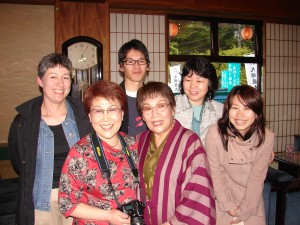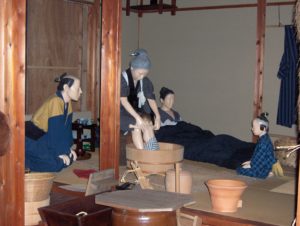In the wake of the catastrophic March 11, 2011, earthquake in Japan, the Japanese Prime Minister Naoto Kan described the current crisis in that country as “perhaps the hardest hardship that we have experienced after World War Two.” My Japanese mother is currently in Tokyo for a two-month visit with her sister and other members of our extended Japanese family. Thankfully, everyone is safe. The US State Department issued the following travel warning for Japan: “The Department of State alerts U.S. citizens to the situation in Japan in the aftermath of a powerful earthquake, measuring 8.9 magnitude, that struck northern Japan on March 11. U.S. citizens should avoid travel to Japan at this time. This Travel Alert supersedes the Travel Alert for Japan dated March 11, 2011, to provide updated information, and expires on April 1, 2011.”
March 10 was the 66th anniversary of a “man-made disaster” that hit the city of my birth, Tokyo. I have to thank my son, Mark, for providing me with much of the historical information and research about this event. When he was in the 9th-grade, he wrote a paper for the National History Day program about the Tokyo firebombing. His interview with my mother provided so much information that I did not know. He also interviewed one of my mother’s cousins, a primary school teacher in Tokyo during WWII. Waves of American B-29s airplanes made the deadliest air raid against Japan on March 10, 1945. That night, my grandmother and two young aunts died, along with over 100,000 people. It resulted in the most devastating civic fire in history.
On the night of March 10, 1945, my mother, age 11, and her younger sister, age 9, were sleeping in a Buddhist temple outside of Tokyo in the Chiba prefecture. Due to the increased bombing raids in Tokyo, the Japanese government evacuated over 230,000 children in grades 3-6 to the surrounding countryside or to the mountains. Boarding schools were set up in temples and hostels. This measure was taken perhaps to spare this younger generation of Japanese. They were lucky to be evacuated. One of my mother’s sisters was too young and another sister, already in junior high, worked in a factory sewing army jackets.
On that terrible night in Tokyo, my grandmother and the two aunts heard the air raid sirens and left quickly to go to a nearby school where there was an air raid shelter. My grandfather, who was crippled with arthritis, followed them as best he could. My grandmother and aunts became disoriented in the smoke and flames and my grandfather ended up taking a different route. He found a pond and took refuge from the fire in the water, which quickly became hot from all of the heat. A fireman told him later that he remembers showing my grandmother and my aunts another way to the school, but that was the last anyone saw of them. My mother and her sister were in bed when someone told everyone to look out the window. My mother recalled, “We saw that Tokyo was burning. We saw the fire over a hundred miles away.”
A week after the March 10, 1945, firebombing, my grandfather wrote to my mother’s school teacher who had been evacuated with his students about how he could not find his wife and two daughters. On the morning that my mother found out about the deaths of her mother and two sisters, everyone in their school was singing victory songs about winning the war. All during that day, students were called to the office to receive bad news about their families. My mother said her younger sister did not want to go when their names were called. My mother’s cousin, a primary school teacher, had been evacuated with over 400 students. Many of his students lost their parents in the Tokyo firebombing and were left orphaned. He remembers having a hard time finding their surviving relatives. A similar scenario is no doubt taking place in northern Japan right now. The death toll is over 10,000. I cannot imagine the heartbreak that so many families are going through.
After March 10, 1945, my mother’s life changed dramatically. Her family was shattered by the firebombing and by the war itself. Three older brothers died from disease during the war. Another brother, who was in the military, barely survived a Chinese prison camp in Manchuria. Her father’s health never recovered, and she lost her childhood when she had to take care of her younger sister and her ailing father in the closing days of WWII and during the American occupation of Japan. My mother and my aunt are survivors and they embrace life at its fullest. I am grateful that they are doing well in Tokyo after the March 11 earthquake.
Since I am an optimist, I would like to offer one recommendation for group leaders who will be visiting Tokyo with their students in the near future. One of the highlights of my 2007 tour to Japan was taking my students to the Edo-Tokyo Museum. Tokyo is truly a modern city and nearly everything has been rebuilt since the end of WWII. To understand and appreciate the history of Tokyo, a stop at this museum is highly recommended. I have been there twice and I certainly hope to return next month if all goes well with our travel arrangements. Through its wonderful visual displays, life-size reconstructions, models, and artifacts, the museum takes you back in time from Tokyo’s beginnings in 1590 as Edo (Tokyo’s old name), the capital of Japan during the Tokugawa Shogunate to 1964, when Tokyo was the host of the 1964 Summer Olympic Games. I especially like the exhibits that show how the Japanese lived during the time of Japan’s seclusion from the rest of the world, which was ended after Commodore Matthew Perry’s arrival in Japan in 1853. Most of the signage is in Japanese, but your students can pick up a great deal about Tokyo’s history in this museum.
There is an exhibit about the Great Kanto Earthquake of 1923, which registered 7.9 on the Richter scale, and resulted in over 100,000 deaths in Tokyo and the surrounding area. The earthquake occurred on September 1, 1923. That anniversary date is “Disaster Prevention Day” in Japan. There is also an exhibit about the bombing raids in Tokyo, including the March 10 firebombing. March 10 has been designated by the Tokyo Metropolitan Government as “Tokyo Peace Day” and the city sponsors many commemorative events. My aunt, who still lives in Tokyo, has attended the special ceremonies for survivors and their families over the years. March 11 will also be designated as another sad anniversary date for Japan.
My departure date for my spring break tour to Japan is April 15 and I still hope that we will be able to go on our tour. I am monitoring the news and reading any updates from the US State Department. I checked EF’s US website on March 11 and read about the “Enhanced Peace of Mind Program for Japan” that offers several options applying to groups and individuals departing to Japan through April 30. I’ll just have to stay tuned to the news from Japan and from EF. Right now, everything is up in the air.
Related articles


